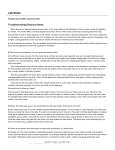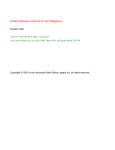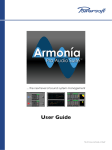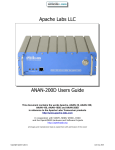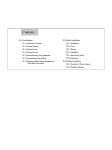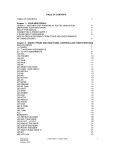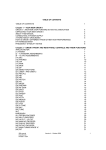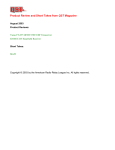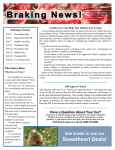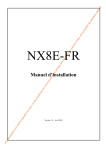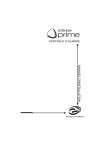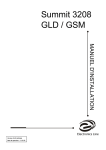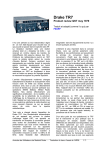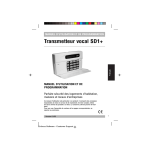Download Product Review Column from QST Magazine
Transcript
Product Review Column from QST Magazine May 1997 ICOM IC-756 MF/HF/VHF Transceiver Japan Radio Co. NRD-535D HF Receiver Copyright © 1997 by the American Radio Relay League Inc. All rights reserved. Product Review Edited by Rick Lindquist, N1RL• Senior Assistant Technical Editor ICOM IC-756 MF/HF/VHF Transceiver By Glenn Swanson, KB1GW Educational Programs Coordinator “Honey, they shrunk the IC-781!” is what some ops will exclaim when they see the IC-756. It’s an easy comparison, and one ICOM ad even calls it a radio “for the ham who’s always wanted an IC-781.” Features like the prominent front-panel LCD display screen on the ’756 certainly hearken back to its elder sibling, the IC-781, with its conspicuous CRT display. As in the IC781, the IC-756 offers such features as dualwatch and Spectrum Scope. But in several respects, this is a different radio— maybe better when you consider its price and performance, the inclusion of DSP, and an intuitive menu system. At least a few reviewers were surprised to find a package closer in dimensions to the IC-736, the radio it replaces in ICOM’s product line. But the IC-756 capitalizes on—and even improves on—some of the best features of its predecessors, and does so with style. Let’s face it: that LCD screen is just plain sexy! The easily accessible menus, spectrum scope and the inclusion of 6 meters are icing on the cake. In the greater scheme of things, the IC-756 is a notch down from higher-end offerings in terms of price, but competes admirably with the big boys in several performance spheres. In terms of DSPequipped radios, the ’756 is intended for more mainstream users. During the review, we encountered some transmitter-related problems that ICOM has agreed to correct in future production units. We’ll discuss these issues later in the review. Feature Highlights The first thing you need to do with the IC-756 is to get past the LCD display window. Otherwise, you could overlook the radio’s other assets. These include such niceties as an automatic antenna tuner (works on 6 meters!), dualwatch, dual antenna ports, a receive antenna port (for a Beverage, EWE or other antenna), memory keyer, front-panel adjustable CW pitch control and tracking sidetone, triple bandstacking registers, twin passband tuning at the 9-MHz IF, and more. A lot of these are features traditionally included on ICOM’s higher-priced radios, so it was great to find them on the more modestly priced IC-756. You’ll also find a generous array of memories and scanning features: 99 memories, plus 2 priority memories; alphanumeric memory naming (up to 10 characters); 5 or 10 memo pads; and four types of scanning. The IC-756 lets you view the contents of nine memory channels at a time (or scroll through them all) via its memory channel screen. Standard accessories include a handmike with UP and DN buttons, a 9 1 /2 -footlong fused dc power cord, spare fuses, a 1 / 4-inch stereo-type phone jack, and large, detailed block and schematic diagrams. The Screen The LCD screen commands the blackplastic face of the ’756. (One user compared it to the screen on the ATM at her bank!) The screen appears dark when the radio is off, but illuminates when you turn the radio on to reveal a light-blue background with dark-blue text, numerals and graphics. A thin (unlighted) black mask frames the screen, and a clear plastic lens protects the flat LCD screen behind it. The screen’s illuminated area measures approximately four inches wide by three inches high—about the same size as the IC-781’s CRT display. BOTTOM LINE To invoke an automotive analogy, if the IC-781 and IC-765 represent ICOM’s high-end race cars, the IC-756 is the full-featured family sedan that takes advantage of modern technology while aiming at the price and performance needs of the general market. The LCD screen needed some “warmup” time to reach proper contrast. We found the display could be easily seen up to 30° off dead center on either side. Tinkering with the contrast levels can make it easier to see. It looks best when you’re directly in front of it, however. What information does the screen convey? The answer is, darn near everything. Save for the nearby analog multifunction meter and some colored LEDs on the front panel, the screen can tell you everything else you need to know. The meter seems a quaint, “retro” touch on a radio featuring a modern, digital LCD window and readout. But several users felt more comfortable with the “real” meter. “Like the hands on an analog clock,” one reviewer explained. In the LCD window, you’ll find information on what frequency each of the two VFOs is tuned to, along with indicators to tell you if such features as split or dualwatch are active (more on dualwatch a bit later). The frequency display (upper) is in bold numerals, while the sub band frequency (lower) is in slightly smaller outlined numerals. It’s possible to set the radio to display resolution down to 1 Hz. A handy 24-hour digital clock (with battery backup) is displayed in the upper righthand corner of the screen. Other displayed information includes which VFO you’re transmitting on (main or sub), along with numerical memory information (memory number and stored frequency). One nice touch appears at the top of the screen, where the display clearly shows which filter bandMay 1997 63 Table 1 ICOM IC-756, serial no 01238 Manufacturer’s Claimed Specifications Frequency coverage: Receive, 30 kHz to 60 MHz; transmit, 1.8-2; 3.5-4; 7-7.3; 10.1-10.15; 14-14.35; 18.068-18.168; 21-21.45; 24.89 -24.99; 28-29.7; 50-54 MHz. Modes of operation: USB, LSB, CW, AM, FM, RTTY Power requirement: Receive, 2.7 A (max audio); transmit, 20 A (max), 13.8V (±15%). Size (height, width, depth): 4.4×13.6×11.4 inches; weight, 23 Receiver SSB/CW sensitivity, bandwidth not specified, 10 dB S/N: 1.8-30 MHz (preamp 1 on), 0.16 µV; 50-54 MHz (preamp 2 on), 0.13 µV. . AM sensitivity, preamp on, bandwidth not specified, 10 dB S/N: 0.5 kHz to 1.8 MHz, 13 µV; 1.8-30 MHz, preamp 1 on, 2 µV. FM sensitivity, 12 dB SINAD: 28-29 MHz (preamp 1 on), 0.5 µV; 50-54 MHz (preamp 2 on), 0.32 µV. Blocking dynamic range: Not specified. Two-tone, third-order IMD dynamic range: Not specified. Third-order input intercept: Not specified. Second-order intercept point: Not specified. FM adjacent channel rejection: Not specified. FM two-tone, third-order IMD dynamic range: Not specified. Squelch sensitivity: SSB, CW, RTTY, less than 5.6 µV; FM, less than 1.0 µV. Receiver audio output: >2 W at 10% THD into 8 Ω. IF/audio response: Not specified. Notch filter depth: Not specified. Spurious and image rejection: Greater than 70 dB. Transmitter Power output: SSB, CW, RTTY, FM, 2-100 W; AM, 1-40 W, continuously adjustable in all modes. Spurious-emission supression: 50 dB (HF bands); 60 dB (50 MHz band). SSB carrier suppression: 40 dB. Undesired sideband suppression: 55 dB. Third-order intermodulation distortion (IMD) products: Not specified. Composite transmitted noise: Not specified. Measured in the ARRL Lab Receive, as specified; transmit, 1.8-2; 3.4-4.1; 6.9-7.5; 9.9-10.5; 13.9-14.5; 17.9-18.5; 20.9-21.5; 24.4-25.1; 28-30; 50-54 MHz. As specified. Receive, 2.3 A (max vol, no signal); transmit, 17.9 A, tested at 13.8 V. pounds. Receiver Dynamic Testing Minimum discernible signal (MDS), 500 Hz IF filters at 9 MHz and 455 kHz: Freq Preamp off Preamp 1 Preamp 2 1.0 MHz –124 dBm n/a n/a 3.5 MHz –134 dBm –139 dBm –139 dBm 14 MHz –134 dBm –139 dBm –142 dBm 50 MHz –131 dBm –139 dBm –141 dBm 10 dB (S+N)/N, signal 30% modulated with a 1-kHz tone, AM-N filter: 1.0 MHz, 3.05 µV; 3.8 MHz, preamp off, 1.07 µV, preamp 1 or 2 on, 0.65 µV; 50.2 MHz, preamp off, 1.43 µV, preamp 1 on, 0.62 µV, preamp 2 on, 0.42 µV. For 12 dB SINAD, FM-N mode: 29 MHz, preamp off, 0.58 µV, preamp 1 on, 0.24 µV, preamp 2 on, 0.19 µV; 52 MHz, preamp off, 0.77 µV, preamp 1 on, 0.30 µV, preamp 2 on, 0.22 µV. Blocking dynamic range, 500-Hz filters at 9 MHz and 455 kHz, preamp 1 on for 1-21 MHz; preamp 2 on above 21 MHz: Freq Preamp off Preamp on 1.0 MHz 135 dB* n/a 3.5 MHz 137 dB 132 dB 14 MHz 132 dB 128 dB 50 MHz 125 dB* 118 dB* Two-tone, third-order IMD dynamic range, 500 Hz IF filters at 9 MHz and 455 kHz, preamp 1 for 1-21 MHz; preamp 2 above 21 MHz: Freq Preamp off Preamp on 1.0 MHz 95 dB n/a 3.5 MHz 101 dB 101 dB 14 MHz 103 dB 100 dB 50 MHz 96 dB* 94 dB Preamp 1 for 1.0-21 MHz; preamp 2 above 21 MHz: † Freq Preamp off Preamp on 1.0 MHz +21.8 dBm n/a 3.5 MHz +14.7 dBm +8.7 dBm 14 MHz +21.0 dBm +10.5 dBm 50 MHz +26.1 dBm –0.7 dBm 14 MHz, preamp off: antenna tuner off, +48.6 dBm; antenna tuner on, +83.5 dBm. At 20-kHz spacing, 29 MHz, preamp off, 81 dB, preamp 2 on, 80 dB; 52 MHz, 67 dB preamp off, 67 dB, preamp 2 on. At 20-kHz spacing, 29 MHz, preamp off, 73 dB,* preamp 2 on, 72 dB;* 52 MHz, preamp off, 69 dB,* preamp 2 on, 70 dB.* At threshold, FM, 29 MHz, preamp 2 on, 0.07 µV; 50.2 MHz, preamp 2 on, 0.37 µV; SSB, 14.2 MHz, preamp 1 on, 0.98 µV 2.1 W at 10% THD into 8 Ω. Range at –6 dB points, (bandwidth): CW-N (both 500 Hz IF filters): 348-813 Hz (465 Hz); CW-W (2.4 and 2.8 kHz IF filters): 216-2717 Hz (2501 Hz); USB-N (2.4 and 2.8 kHz IF filters): 239-2765 Hz (2526 Hz); LSB-N (2.4 and 2.8 kHz IF filters): 218-2720 Hz (2502 Hz). ≥50 dB. IF rejection, ≥120 dB; image rejection, ≥120 dB. Transmitter Dynamic Testing As specified. 55 dB or greater on HF; greater than 60 dB on 50 MHz. Meets FCC requirements for equipment in its power output class and frequency range. 55 dB or greater. As specified. See Figures 1 and 2. See Figures 4 and 5. Note: Unless noted otherwise, all dynamic range measurements were taken at the ARRL Lab standard spacing of 20 kHz. *Measurement was noise-limited at the value indicated. † Third-order intercept point was determined using S5 reference. 64 May 1997 0 0 Reference Level: 0 dB PEP Reference Level: 0 dB PEP –10 –10 –20 –20 –30 –30 –40 –40 –50 –50 –60 –60 –70 –70 –80 –10 –8 –6 –4 –2 0 2 4 Frequency Offset (kHz) 6 8 10 –8 –6 –4 –2 0 2 4 Frequency Offset (kHz) 6 8 10 ICOM IC 756 S/N 01238 ICOM IC 756 S/N 01238 Figure 1—Worst-case spectral display of the unmodified IC-756 transmitter during two-tone intermodulation distortion (IMD) testing at 28.350 MHz. The worst-case third-order product is about 24 dB below PEP output, and the worst-case fifth-order product is about 34 dB down. The transceiver was being operated at 100 W output. (See text for additional details.) width is currently selected at each IF. Everyone also liked the fact that as you manipulate the concentric twin passband tuning ( TWIN PBT ) controls on the front panel, a handy passband width graphic shows you the relative IF bandwidth and shift. But one of this radio’s very best attributes is the ease of access to user-settable adjustments, or “menus.” On some more expensive radios, these settings are relegated to separate, complex, nonintuitive menu systems that confound the user and require spending hours with the manual. Not so with the IC-756. In fact, getting to the plain-language menus was so easy, many users were able to tailor user-settable parameters without referring to the book! (Thank you, ICOM!) In fact, most users didn’t need the manual at all to operate the entire radio. Shades of the IC-781, a horizontal row of F unction keys (F1 through F5) is below the LCD screen, and on-screen legends above each key indicate the key’s function, depending on the menu (ICOM calls it a set mode) selected. For example, contrast and S meter backlighting controls allow you to adjust these levels to your liking. Just press F5 ( EXIT ) until you reach set mode. Then, choose F2 (Display Set), and use the F1 and F2 keys (now defined as up and down arrows) and spin the VFO knob to adjust LCD contrast, brightness and the backlighting levels for the S meter and push buttons. Each adjustment has a little percentage scale, which makes it easier to remember “your” settings. On menus where it’s appropriate, one button restores default (DEF) settings. When you’re done, press F5 to EXIT the set mode. A vertical row of seven multifunction buttons is arranged down the left-hand side of the display window. Just like the F unction buttons, a corresponding column of onscreen labels conveys the role each button –80 –10 Figure 2—Spectral display of the unmodified IC-756 transmitter during two-tone intermodulation distortion (IMD) testing at 50.2 MHz. The worst-case third-order product is approximately 37 dB below PEP output, and the worst-case fifth-order product is approximately 33 dB down. The transceiver was being operated at 100 W output. (See text for additional details.) Figure 3—CW keying waveform for the unmodified IC-756 showing the first two dits in full-break-in (QSK) mode. The equivalent keying speed is 60 WPM. The upper trace is the actual key closure; the lower trace is the RF envelope. Horizontal divisions are 10 ms. The transceiver was being operated at 100 W output at 14.2 MHz. Note that the first dit is somewhat shortened. This is much less evident in semi-break-in mode. plays in a given set mode. For example, a button next to the AGC label lets you toggle between fast, middle and slow AGC settings; holding it in momentarily turns off the AGC. The AGC action was flawless. Another button selects ANT 1 or ANT 2; holding it in momentarily in either position lets you select a separate receiving antenna (more on this later). Other items the user can tweak give you the ability to tailor your transmit audio (this is done using DSP). You also can set a timer to turn the radio on or off at a preset time, or set the radio to beep at you when you go out of band. You can also make adjustments for CW sidetone level. Some hard-core CW buffs might not want to hear this, but you don’t even need to know the code to program the memory keyer! Using the keyer set mode, you can change the plain-lan- guage messages for each of the keyer’s four 55-character buffers to send whatever messages you need. Programming the keyer requires a lot of button pushing, however; more than a few CW ops will balk at not being able to simply record their messages from their paddles. One nice touch: the keyer offers sequential QSO serial numbering. The keyer speed range is approximately 6-47 WPM. There are five little “stem” controls along the front panel’s bottom apron. These include adjustments for mike gain, RF power, compression level, keyer speed and break-in delay. Unlike similar controls on the IC-781, you can’t push these back in and out-of-sight. And the Spectrum Scope While appealing at first blush, the spectrum scope drew mixed opinions from our review team about its usefulness in the real world. While the IC-756 spectrum scope looks similar to the one on the earlier IC-781, ICOM says it’s implemented differently. The IC-756 spectrum scope has its own RF amplifier and AGC, making it independent of the S meter and the RF gain control. It is affected by the preamps, though. One user said he found it interesting to watch the fading patterns on 40-meter HF broadcast stations one afternoon, especially noting the timing of the fades, which differed from signal to signal. But the same op and others found little use for the spectrum scope for contesting. Another op called the spectrum scope “kind of fun,” and suggested it was a handy tool for spotting band activity. We found that the display requires a moderately strong signal (S4 or so) just to show up on the graph, and a pretty hefty signal to really be seen. The image does not refresh rapidly enough to catch signal splatter, and on a very busy band, everything May 1997 65 –60 –70 –60 Reference Level: - 60 dBc/Hz Vertical Scale: dBc/Hz –70 –80 –80 –90 –90 –100 –100 –110 –110 –120 –120 –130 –130 –140 2 4 6 8 10 12 14 16 18 20 Frequency Sweep: 2 to 22 kHz from Carrier 22 ICOM IC 756 S/N 01238 DSP Highlights The IC-756 borrows heavily from the IC-775DSP for its DSP features—especially in the superb implementation of its noise-reduction ( NR ) feature, which earned our praise in the IC-775DSP review (see “Product Review,” QST, Jan 96). Like its big brother, the ’775DSP, the ’756 uses DSP to equalize transmit audio as well as for its automatic IF notch filter, audio peak filter (APF) and phase shift network (PSN) modulation and demodulation. Most users felt the noise reduction was among the radio’s finest DSP features on receive, but the usable range on the NR control is very restricted. About one-quarter turn is as much as you’ll ever need to quiet things down. It even worked on atmospheric noise, and it did not exhibit that annoying hollow sound we’ve noticed on some other DSP NR systems. One user liked the NR on the ’756 better than the one on his acclaimed outboard box, explaining how stations “popped intelligibly out of the noise” when he turned the pot. We got contrasting viewpoints on the audio peak filter ( APF). Opinions ranged from “useless” to “worked like magic.” Consensus was that it was great for beefing up solitary CW signals, like beacons, and for punching up one signal among a small group, but it was less effective on a busy 66 May 1997 4 6 8 10 12 14 16 18 20 Frequency Sweep: 2 to 22 kHz from Carrier 22 ICOM IC 756 S/N 01238 Figure 4—Worst-case tested HF spectral display of the unmodified IC-756 transmitter output composite-noise testing at 3.5 MHz. Power output is 100 W. The carrier, off the left edge of the plot, is not shown. This plot shows composite transmitted noise 2 to 22 kHz from the carrier. starts to look like choppy seas—from shore to shore. On the other hand, like the similar feature on the IC-706, spectrum scope should prove to be a great help in checking out more quiet bands like 6 meters, which has been less than busy of late. Using the spectrum scope, you can quickly spot other activity on the band while parked on the calling frequency, although the signals will have to be substantial to show up as much more than little blips on the horizon. One VHF op suggested the spectrum scope would make it easier to avoid “the troublesome big-signal stations” on the band. –140 2 Reference Level: - 60 dBc/Hz Vertical Scale: dBc/Hz Figure 5—Spectral display of the unmodified IC-756 transmitter output during composite-noise testing at 50.2 MHz. Power output is 100 W. The carrier, off the left edge of the plot, is not shown. This plot shows composite transmitted noise 2 to 22 kHz from the carrier. band. APF offers three bandwidths. On FM, it works as a tone control. The DSP automatic notch works well to eliminate those pesky heterodynes that crop up on the HF bands that are shared with broadcasters in other parts of the world. Anyone who’s operated 40 meter SSB at night in the Northeast will appreciate this feature. But one CW op said that lack of an equally effective manual notch made it “half a feature,” since an auto notch is useless on CW. The auto notch is outside the AGC loop, so you’ll still see the interfering signal on your S meter (and on the spectrum scope), even though you can’t hear it—and it can still affect your receiver’s front end. The ability to tweak transmit audio to taste was a real plus. Everyone’s voice is different, and this DSP feature bursts through the old “one size fits all” mentality, letting you customize the equalization for your voice. Users liked being able to use the transmit audio “treble” and “bass” settings (quickly accessible via the userfriendly menu) to optimize transmit audio the way they needed it—from “really punchy contest audio” to “pleasant, conversation-quality audio.” The built-in monitor lets you hear your own signal. The IC-756 follows up its fine DSP audio equalization system with AF-level speech processing. While you can use the ALC scale on the multifunction meter to set a maximum level (using one of the little stem controls on the front-panel apron), you really have no idea how much or how little compression (ie, how many dB) you’re cranking in. IF Filters The IC-756 can be equipped with up to two optional narrow IF filters—one each in the 9-MHz and 455-kHz IFs. In other words, you must choose between either SSB or CW filters. This is one drawback in what is otherwise a flexible and generally well-thought-out radio. Optional CW and data-mode filters offering bandwidths of 250, 350, or 500 Hz are available for both IFs. For SSB, there’s an optional 1.9-kHz filter in the 9-MHz slot and a 1.8-kHz filter for the 455-kHz IF. It’s a shame you can’t add both types at the same time. Bringing narrow IF filter(s) into play is as easy as making other menu choices. We felt this filter-selection scheme was a decided (and welcome!) improvement over the LED push button–based filter-selection system employed in the IC-775DSP— while also recognizing that the ’775DSP also offers more filter choices. The Flip Side The rear “panel” on the ’756 is not a separate panel at all. It’s actually part of a 4-inch-high cast-aluminum framework that surrounds the radio’s innards (save for the front panel, which is mounted in front of the aluminum chassis). Rear-panel connections for all the usual suspects are there— plus the additional receive antenna port and a straight key jack and two DIN plugs for a variety of external connections. Most users would rather have had individual labels on each jack or connector, instead of the single plate in the middle of the panel. The IC-756 has no transverter port. Computer control is possible via the REMOTE jack, but you’ll need the optional CT-17 CI-V level converter. On The Air Our IC-756 hit the ground running—in large part because the steep learning curve encountered with some new transceivers simply didn’t exist with the IC-756. The radio put in an appearance in several contests, including the ARRL International DX Contest (CW and SSB) and the CQ 160-Meter SSB Contest. It also got used on 10 and 6 meters and for casual ragchewing on HF CW and SSB. An internal fan, just behind the front panel, kept the radio cool even during long contest operation. We never heard it. Same for the automatic antenna tuner, which uses a combination of motors and relays. Our review team found the receiver performance above average. Our unit had the optional 250-Hz CW filter in the 9-MHz IF and an optional 500-Hz CW filter in the 455kHz IF. Experienced CW operators said this yielded a receiver with sufficient selectivity for all but the most demanding circumstances. Users felt the twin passband tuning gave an added edge in troublesome QRM situations, although one op who used the radio for SSB said the twin PBT was not a substitute for the narrow filters on that mode. The CW PITCH control gives you sufficient latitude to suit nearly all tastes, even for one reviewer who likes to copy his code at a pitch of 280 Hz. In-band audio IMD—something we’ve criticized ICOM radios for in past product reviews—was not a problem with the IC756. Receiver audio quality was judged to be on a par with other radios in its price class. The ARRL Lab reported third-order products improved by 14 dB over the unmodified IC-775DSP (in the AGC fast setting) that we looked at last year (see “Product Review,” QST, Jan 1996). The internal, automatic antenna tuner is active on all bands and works in receive as well as transmit. Using it on receive certainly raised the radio’s second-order intercept point (see Table 1), from +48.6 dBm to a very respectable +83.5 dBm (with the preamp off). Second-order dynamic range improved by approximately 17 dB (with the preamp off) when using the built-in antenna tuner during receive. Unfortunately, we could not will the 6-meter band to open, so we were unable to gauge the radio’s performance during a busy day on “the magic band.” The transceiver tunes below 50 MHz, so the 6-meter DXer can check for those overseas TV carriers that alert ops to openings. If the Lab numbers (see Table 1) are any indication, the IC-756 should perform very well on 6 meters. For starters, it should be able to hear those weak signals; receiver sensitivity on SSB and CW was comparable to the IC-736 (–141 dBm with preamp 2 turned on). Two-tone third-order IMD dynamic range (with preamp 2 kicked in) was 12 dB better than the ’736. That’s something you’ll be glad of when you’re sorting through a band-opening, with its mixture of very loud and very weak signals close together in frequency. Dualwatch is a nice touch. Six-meter fans, for example, will appreciate the ability to monitor both the 50.110 MHz and 50.125 MHz calling frequencies at the same time— a big plus! But the sub band receiver is strictly for in-band use, and it won’t let you listen to two signals on different bands— say on 6 and 10 meters—at the same time so you can keep one ear on the 10-meter liaison frequency. (For more details on how dualwatch works, see “Product Review,” QST, Jan 96, p 67.) One primarily VHF op enthused about the noise blanker, saying that it “worked as well as the noise blanker any rig I have tried and better than most.” He found that it worked great for the intended purpose of minimizing pulse-type noise, but it didn’t make much of a dent in troublesome noise emanating from a nearby high-tension line. (He said both noise sources cooperated by “being especially noisy during the review period.”) For the most part, our review team liked the front-panel-selectable separate receive antenna input, which served to connect a Beverage antenna for contest use on the low bands.1 “The other manufacturers could learn something from ICOM,” one user said. A few ops found it was too easy to inadvertently switch to the second antenna port instead of the receiving antenna, however. The radio’s two preamps and three levels of attenuation also elicited praise for their versatility. So did the inclusion of ∆TX (transmit incremental tuning). You can clear RIT while transmitting—but the knob’s pointer might be heading in just about any direction when you do.) The ease of operating split drew starkly contrasting opinions. Some ops had no problems with which buttons to push, but others found the user interface confusing. ICOM combines the typical A=B and A/B functions into a single CHANGE button, which serves both purposes, depending on how long you hold it in. This befuddled some ops. Most ops also would have preferred a more prominent means of indicating which VFO was set for transmit. The IC-756 transmitter did not fare as well as we’d hoped. After the IC-756 served ably during the ARRL International DX CW Contest, we received some troubling reports that its CW signal was particularly noisy. ARRL Lab tests showed that CW sidebands2 did, indeed, extend beyond the bounds of reasonable expectation. We tested two IC-756s plus several other ICOM and non-ICOM radios. Lab testing determined that, at 2 kHz away from the signal on the (worst-case) low side, the CW sidebands of our IC-756 were 13 dB worse than those of an IC-706 and 7 dB worse than those of an IC-765. At 10 kHz away, the CW sidebands were 14 dB worse than those of an IC-706 and 24 dB worse than those of an IC-765. Lab Supervisor Ed Hare, KA1CV, predicted that keying sidebands of this level would “have an adverse impact on other users of the band.” We discussed this issue with ICOM, and the manufacturer subsequently sent us another IC-756 that had been modified to correct the wide CW signal problem. We found the modified radio to be vastly superior in this regard. While not as clean as an IC-765 we’d tested, the IC-756’s CW spectral display was slightly better than that of the IC-706. In addition, the keying waveform was much cleaner on the modified radio and showed none of the rough edges we’d noticed in the first two units we’d tested (see Figure 3). (Our Expanded Test Report on the IC-756 includes graphs of the radio’s keying sidebands and those of other radios for comparison.—Ed) Judging from the two-tone transmit IMD plots we took (see Figures 1 and 2), the IC-756 might sound “wide” on SSB on some bands. The transceiver’s worst-case transmit two-tone IMD on MF/HF was 10 meters, where testing not only revealed mediocre suppression of third and fifthorder products (down 24 and 34 dB respectively), but showed subsequent higher-order products persisting at rather high levels (not until the 13th order do IMD products drop to –55 dB). These are the culprits that cause undesirable “splatter.” That said, we’d like to point out that IMD performance on 160 through 20 meters was on a par with other transceivers we’ve seen lately, and higher-order products (ie, beyond fifth order) were at or below –60 dB in most cases. Transmit IMD performance started to degrade at 17 meters and got progressively worse through 10 meters, not only with respect to third-order numbers but to higher-order products. Transmit IMD performance of the IC-756 was much worse than that of the earlier IC-738 (see “Product Review,” QST, Apr 95), which had worst-case third and fifth-order products of –40 dB. Like the IC-738, the IC-756 uses bipolar transistors in the PA (as opposed to power MOSFETs). On the other hand, 6-meter transmit IMD performance of the IC-756 was notably better than that of the predecessor IC-736, but higher-order IMD products do not drop below –40 dB until the 15th order. On bands with these levels of transmit IMD, an amplifier could tend to exacerbate the problem on the air. It was interesting to note that the IC-756 that ICOM had modified to fix the CW sidebands problem also exhibited far superior reduction of higher-order transmit IMD products. While the third and fifthorder products on 10 meters and 6 meters were comparable to those of the other two IC-756s we’d tested, the higher-order products on those bands were much less evident on the modified radio. ICOM expressed its appreciation to the ARRL for its findings with regard to the performance of the IC-756 and said: “We continually refine and update our products. All production of the IC-756 from April 1, 1997 will include changes made to improve the CW characteristics of the transceiver.” ICOM said the CW modification also would improve the transmit IMD performance. Of considerably less importance were reports of choppy or “clipped” keying when using the internal keyer and full break-in at speeds much more than 30 or 35 WPM. The radio lets you change the dot-to-dash ratio, but only very slightly, and this made only minimal improvement. Instruction Manual After all the hoopla that surrounded the introduction of the first transceivers with integrated DSP, it’s just a little curious that May 1997 67 ICOM’s Instruction Manual downplays DSP on the IC-756. ICOM’s ads mention “IF-DSP,” but you’d have to look very carefully to find the expression “DSP” anywhere in the Instruction Manual (it’s on the block diagram). DSP is hardly passé, but have we reached the point where there’s no longer a need to point out that a radio has DSP? At least one reviewer felt it would be nice if the manual contained a simple “DSP” next to each of the headings that describe DSP-based features. There were few complaints about what the manual does include, however. Optional IF filter installation, setup, and operation did involve a bit of jumping from page to page to find relevant information, but the text offers pointers to pertinent pages for most subjects, including how to install options. Step-by-step items labeled CONVENIENT point out how you might use dualwatch, for example. Other text boxes labeled PRACTICAL EXAMPLE illustrate such things as how to initiate split operation. Overall, a generous combination of diagrams, drawings and succinct text contribute to a no-nonsense approach. Conclusions One op who spent some time with the IC756 summed things up this way: “Generalpurpose operators or DXpeditioners will find that the IC-756 offers an abundance of features to cope with what they’ll find on the bands.” The tools are there to help eliminate QRM and dig out the weak ones. The small size is great for anyone who needs to travel with a radio (of course, they would have to bring along a suitable power supply). It even has a carrying handle. In the final analysis, the review team got good audio reports, liked the user interface (for the most part), and found the layout of the front-panel controls to be clear and uncomplicated. Thanks go to the following hams who contributed to this review: Randy Thompson, K5ZD; Dave Sumner, K1ZZ; Linda Sumner, KA1ZD; Mark Wilson, K1RO; Peter Budnik, KB1HY; Emil Pocock, W3EP; Rick Lindquist, N1RL; and Mike Gruber, W1DG, and Ed Hare, KA1CV, of the ARRL Lab. Manufacturer: ICOM America Inc, 2830 116th Ave NE, Bellevue, WA 98004, tel 206-454-8155; fax 206-454-1509; WWW http://www.icomamerica.com. Manufacturer’s suggested retail prices: IC-756, $2760; PS-85 dc power supply, $325; SM-20 desktop microphone, $248; 9-MHz IF filters: FL-223 (1.9 kHz), $84; FL-100 (500 Hz), $106; FL-232 (350 Hz), $90; FL-101 (250 Hz), $106; 455-kHz IF filters: FL-222 (1.8kHz), $199; FL-52A (500 Hz), $196; FL-53A (250 Hz), $196; CT-17 computer interface, $135. Notes 1 With many radios that offer a receive antenna port that remains in line while transmitting, you’ll need to protect the transceiver from adverse reactions by adding a device to iso- late the rig from your own transmitted signal. This station-engineering issue may apply to those with receive antennas such as Beverages or EWEs. One solution is to wire a relay to switch the separate listening antenna connection to ground (or to at least isolate the antenna’s feed line from your receiver) during transmit. For a specific approach, see “Beverage Antennas—There’s More to Them Than Meets The Eye,” by Gary R. Nichols, KD9SV, CQ , Feb 97. 2 It might sound strange, but a CW signal also has sidebands. It makes more sense if you think of a CW signal simply as a carrier that’s being “modulated” by a square wave (on-off keying). Take a look at the keying envelope in Figure 3. Expanded Product Review Report Available The ARRL Laboratory offers a comprehensive test result report on the IC-756 that gives in-depth, detailed technical data on the transceiver’s performance, outlines our test methods and helps you interpret the numbers and charts. The report even includes a summary of how this radio stacks up with similar previously tested units. Reports are $7.50 for ARRL members and $12.50 for nonmembers, postpaid. Request the IC-756 Test Result Report from the ARRL Technical Department, 225 Main St, Newington, CT 06111 (personal checks accepted). For credit card orders only, call 860594-0278. Japan Radio Co. NRD-535D HF Receiver Reviewed by Larry Wolfgang, WR1B Senior Assistant Technical Editor I don’t own a transceiver with generalcoverage receive coverage, and I haven’t done much shortwave broadcast listening lately, so getting my hands on this receiver was a treat. The NRD-535D, first introduced a half dozen years ago, has proved an able and popular performer among SWL/BC DXers, but many hams might not be familiar with it. I found it to be a full-featured radio that is at home on the ham bands as well as outside them, so if you’ve got a yen for listening, you might want to check out this fine receiver. The NRD-535D is the fourth generation in Japan Radio Company’s line of generalcoverage receivers. We didn’t review the NRD-505, but we reviewed its similar-looking predecessor, the NRD-525, almost nine years ago (see QST, Jul 88), and its predecessor, the NRD-515, seven years before that (see QST, Nov 81). The NRD-535D retains many of the features of the predecessor ’525—and some of its flaws. Those familiar with the earlier model will find that, although the front panel has a more modern look to it, the control layout is very similar. We reviewed the deluxe version NRD535D (Gilfer Shortwave offers a soupedup NRD-535GS. Details are on the Gilfer Web page at http://www.gilfer.com/ 68 May 1997 jrc535gs.htm). 1 The ’535D includes the bandwidth control module; the exalted carrier, selectable sideband (ECSS) unit and the “narrow” 1-kHz filter. THE BOTTOM LINE The JRC NRD-535D is a proven performer among BC and SWLers, and it could be a great complement to the ham shack too. It’s loaded with features and a pleasure to listen to. From the Front If you squint, the ’535D resembles JRC’s JST-245 amateur transceiver (see “Product Review,” QST, Sep 95). It’s a good-looking radio with smooth lines and plenty of nicesized knobs and buttons to play with! But not too many. There are no concentric controls either, something that those with big fingers might appreciate. The top left side of the radio includes the fluorescent display, with frequency, mode, bandwidth, S meter and other operational information. Below the display are mode buttons for Table 2 Japan Radio Corp NRD-535 Communications Receiver, serial number 68926 Manufacturer’s Specifications Frequency coverage: 0.1-30 MHz. Modes of operation: AM, USB, LSB, CW, RTTY, FAX, and NFM. Power requirements: 100/120/220/240 V ac ± 10%; 12-16 V dc (13.8 V standard), at approx 2 A. Size (HWD): 5.2×13.2×11.5 inches; weight, 19.8 lb. CW/SSB sensitivity, 10 dB S/N, INTER filter: 0.1-0.5 MHz, 5.0 µV (–93 dBm); 0.5-1.6 MHz, 2.0 µV (–101 dBm); 1.6-30 MHz, 0.32 µV (–117 dBm). AM sensitivity, 10 dB S/N, INTER filter: 0.1-0.5 MHz,15.8 µV; 0.5-1.6 MHz, 6.3 µV; 1.6-30 MHz, 2.0 µV. FM sensitivity, 12-dB SINAD, INTER IF filter: 1.6-30 MHz, 0.5 µV. Blocking dynamic range: Not specified. Two-tone, third-order IMD dynamic range: 106 dB (channel spacing not specified). Second-order intercept point: Not specified. FM adjacent channel selectivity: Not specified. FM two-tone third-order dynamic range: Not specified. IF/audio response: Not specified. Measured in ARRL Lab As specified, with some usable sensitivity below specified lower limit. As specified. DC current drain: 1.1 A (max volume, no signal), tested at 13.8 V dc; Lab testing conducted using 120 V ac. Minimum discernible signal (MDS), NARROW (1000-Hz) IF filter: 180 KHz, –133 dBm; 500 kHz, –134 dBm; 1.0 MHz, –134 dBm; 3.5 MHz, –138 dBm; 14 MHz, –135 dBm; 28 MHz, –136 dBm. AM, WIDE IF filter, test signal modulated 30% with a 1-kHz tone, 10 dB (S+N)/N: 1 MHz, 0.58 µV; 3.8 MHz, 0.46 µV. FM, 12-dB SINAD: 29 MHz, 0.3 µV. CW mode, narrow (1000-Hz) IF filter: 1.0 MHz, 121 dB;* 3.5 MHz, 122 dB;* 14 MHz, 118 dB.* CW mode dynamic range and third-order intercept point narrow (1000-Hz filter) IF filter: Frequency Dynamic Intercept point (MHz) Range (dB) (dBm) † 1.0 91* +6.3 3.5 94 +4.3 14 94 +5.2 +73 dBm. 29 MHz, 62 dB. 29 MHz, 65 dB.* Range at –6 dB points, (bandwidth): CW-N, 47-1195 Hz (1148 Hz); CW-INTER, 64-1701 Hz (1637 Hz); CW-W, 106-2432 Hz (2326 Hz); LSB-N, 825-2176 Hz (1351 Hz); LSB-INTER, 346-2396 Hz (2050 Hz); LSB-W, 83-2537 Hz (2454 Hz); USB-N, 838-2185 Hz (1347 Hz); USB-INTER, 540-2545 Hz (2005 Hz); USB-W, 70-2777 Hz (2707 Hz); AM-INTER, 42-1185 Hz (1143 Hz); AM-W, 42-2410 Hz (2368 Hz). 121 dB* 121 dB* ≥30 dB. At threshold, SSB, 14.2 MHz, 0.52 µV; FM, 29 MHz, 0.46 µV. 1.0 MHz, S9, 88.0 µV; 14 MHz, 65 µV. 2.1 W at 10% THD into an 4-Ω load. IF rejection: 70 dB or better. Image rejection: 70 dB or better. Notch attenuation: 40 dB or greater. Squelch sensitivity Not specified. S-meter sensitivity: Not specified. Audio output: 1 W or greater at 10% distortion into an 4-Ω load. Line out/ RECORD level: Not specified. 590 mV into a 600-Ω load (S9 signal). NOTE: All dynamic-range measurements were taken using the ARRL Lab standard spacing of 20 kHz. *Measurement was noise-limited at value shown. † Third-order intercept points were determined using S5 reference. RTTY , CW , USB/LSB , AM, FM and FAX . When used with the FUNCTION button, each mode button serves a second purpose, such as selecting the display brightness, controlling the clock and timer features, selecting frequency and memory channel scan features and activating the 20-dB attenuator. Below the mode buttons are controls for setting the blanking level of the twin noise blankers—a welcome feature. The noise blankers were quite effective. Also below the mode buttons are the bandwidth control ( BWC; new with this model), passband shift ( PBS; also new), squelch, variable notch position and RF gain. The main tuning knob is large, with an uncalibrated analog apron. It has the now-commonplace finger-sized depression to make rapid spinning easy. The rubberized, textured grip has a nice feel. Just above the main tuning knob are two “arrow” buttons: < and >. These can be used to tune the radio, one tuning step at a time for each button-press. If you hold either of these buttons in, the radio will tune up (>) or down (<) the band. These buttons select the memory channel in memory mode. Another series of buttons above the tuning knob allow you to select more functions. The BANDWIDTH button selects one of four IF filters (narrow, intermediate, wide and auxiliary). AGC selects the fast or slow AGC action or turns it off completely. TUNING RATE selects 10Hz, 100 Hz or 1 kHz tuning steps. The CHANNEL and FREQ buttons switch between the VFO and 200 memory channels (more on this later). There is also a button to turn on what JRC calls its “exalted carrier, selectable sideband” (ECSS) feature—which appears to be a synchronous detection scheme. This reduces the “garbling” effects of selective fading of AM signals, where the carrier frequency fades, leaving only the sidebands.) The ECSS works quite well. While in the ECSS mode, you can choose the sideband farthest from an interfering signal, to minimize the interference. To use it, you press the ECSS button and select USB or LSB , as appropriate, effectively removing the other sideband and carrier. Compared with the standard AM mode on the radio, we found slightly improved audio fidelity of AM signals (even on the ham bands) using ECSS. Tuning can be a bit tricky when using this feature. If you’re not within 500 Hz of the desired carrier frequency before turning ECSS on—or if the radio can’t lock onto the carrier—you will hear a loud squeal. I found it easier to first tune in the signal in SSB mode, perhaps because I have had more May 1997 69 experience tuning in SSB than AM. The front panel also includes a numeric keypad for direct frequency entry and to set other options. There are rotary AF GAIN and TONE controls too. From the Back The rear panel has a full complement of connectors. The radio has a built-in ac power supply (for 100, 120, 220, or 240 V ac input, settable at the fuse holder), but you can also power the radio from a 12 to 16 V dc supply (capable of at least 2 A). An antenna connects via an SO-239 (50-Ω) connector or unbalanced high-impedance (600-Ω) wire antenna push-terminals (for the antenna wire and ground). A DC OUT jack supplies 10.8 V dc at up to 30 mA to run a station accessory. Audio is available on the LINE OUT and EXT ernal SP eaker jacks. For RTTY operators, there are jacks for the MARK and SPACE signals, which can be used with an oscilloscope as a tuning indicator with the optional RTTY demodulator installed. The SCAN HOLD jack provides a way for you to temporarily stop the scan operation and the MUTE JACK allows you to disable the receiver by grounding this line. This is especially handy if you want to use the ’535 in your ham station with a separate transmitter or transceiver. The AF, IF and RF stages are muted and the 20-dB attenuator is activated, and JRC says this provides more than 120 dB of antenna isolation, so you should be able to monitor your transmitted signal off the air in the mute position. The NRD-525 also had an auxiliary RF gain pot that you could adjust to set receiving level while muted. The NRD-535D doesn’t have that, nor does it offer a transmitter sidetone input connection, as the ’525 did. Also, there is no provision to connect the VFO signals between the ’535 and a transceiver or transmitter (not even a JRC transceiver). A means to connect this receiver to my transceiver so I could use either VFO or operate split or dual receive would have been a useful addition. There are three terminals for use with the timer feature, which makes it possible to operate a tape recorder or other device for unattended recording. This can be set up to connect one set of terminals when the timer is on and another set when the timer is off. You can also configure the operation of the “timer off” contacts to turn on only when the squelch threshold is broken. The NRD-535D back panel also has an RS-232C port. When it’s connected to a computer loaded with appropriate software, 2 you can control just about every radio operation through this port. Among other things, you can set the receive frequency, select the bandwidth by specifying the IF filter and adjusting the bandwidth control, set the clock and set RTTY parameters from your computer. You can also read the various receive parameters to determine the radio operating conditions from a remote location. There’s a list of commands in the 70 May 1997 Instruction Manual, but the manual skimps on how to actually get computer control up and running. More Operating Controls Sixteen of the radio’s default CPU parameters can be changed via menus to suit your operating preferences. Some of the parameters seem rather esoteric, while others are more vital. I can’t get too excited about being able to make the colon in the time display blink or remain steady, but I sure do like the ease with which I can change the CW offset over a range of ±5000 Hz! If you prefer an S-meter display with a “needle” indicator rather than a bar, you can make that change in the menu. If the main tuning knob rate of 1000 steps per revolution is too fast, you can slow it down to only 250 steps per revolution. If you want to eliminate the slight signal attenuation introduced by the receiver frontend filters, you can bypass them via a menu selection. This may help you pull in that extremely weak signal, but will also increase interference from strong signals over a fairly wide frequency range. You probably wouldn’t want to “set and forget” that one, but it might prove valuable at times. Circuit Features The NRD-535D is a triple-conversion superheterodyne receiver with IFs of 70.455 MHz, 455 kHz and 97 kHz. For FM reception, only the first two IFs are active. The selectable filters are part of the second IF. The WIDE filter has a 6-dB bandwidth of 6 kHz and the INTERmediate filter has a 6dB bandwidth of 3 kHz. You can narrow the effective bandwidth of both of these with the bandwidth control. The BWC does not work in the NARROW filter position. With no auxiliary filter installed, the effective bandwidth is 12 kHz. The ’535 uses a phaselocked loop and direct-digital synthesis hybrid to control the operating frequency. By the Numbers Tests in the ARRL Lab suggest this receiver should perform well (see Table 2). As was the case in the ’525, sensitivity in the NRD-535D is not reduced automatically in the vicinity of 1 MHz (ie, the AM standard broadcast band). We found that sensitivity was fairly uniform across its tuning range. AM sensitivity was a bit better than what we measured on the ’525. Dynamic range is an important consideration for any receiver, especially if you’re listening in the highly populated areas of the spectrum. Two-tone, third-order IMD dynamic range numbers were comparable to those of the earlier NRD-525; so were third-order intercept figures. Especially remarkable was the in-band audio IMD performance of the NRD-535. Lab tests showed that in-band IMD was mini-mal. That obviously contributed to the clean, crisp audio we noted. The NRD-535 offers a variable IF notch filter that minimizes—but might not eliminate—interfering signals, especially strong ones. It’s useful, but it’s not as effective as the newer DSP filters, and our Lab tests showed that the notch filter missed its specified 40 dB depth by 10 dB. You can listen a bit outside the radio’s specified 0.1 to 30 MHz tuning range— an undocumented bonus. Like the earlier ’525, our NRD-535D would tune to 0.00 kHz, but many spurs were evident below the 100-kHz lower tuning limit, and we found that noise increased drama-tically below 20 kHz. In addition, sensitivity began to drop off as we tuned below 100 kHz, to around –93 dBm at 20 kHz. Sweeping, Scanning and Memories There are two types of scanning possible with this radio. JRC refers to the process of searching through the memories as scanning. You set up this mode by setting the start and stop memory numbers, and then hitting the RUN button. There is no way to “skip” certain memory channels within the range you set (the NRD-525 could not do this either). I would have preferred more flexibility, although you can program the memory data such that those channels you want to skip are outside the selected range. If you want to search through a certain frequency range you use the sweep feature. Again you select the start and stop frequencies and then hit the RUN button. There are user options to set the time the radio will spend on each channel or frequency (0.5 to 5 seconds for scan and 0.05 to 0.5 second for sweep). The default condition is to continue scanning after that time, whether there is a signal on frequency or not. Again, you can change that condition with a user option, so the radio will pause on that channel or frequency as long as a signal is present. Memory channels can be used in so many ways. The ability to store a frequency so you can come back and check it later is invaluable. The ’535D has 200 memory channels (the same as the ’525)—all tunable—and each one stores all operating information, such as mode, bandwidth and AGC setting. I found that changing between VFO and memory operation was a bit quirky—as it was with the earlier NRD-525. When you first switch from VFO to memory operation, the radio displays the frequency that was on the dial with all the same operating settings, but showing the last-used channel number. If you change memory channels and then go back to the original, you then will have the settings that were previously stored with that channel. But, when you switch back to VFO operation, you will have the same frequency and settings as the memory channel. The radio won’t save the frequency and settings you had when you were in VFO operation, and there’s no way to retrieve them—unless, of course, you remembered to store them before switching to memory operation! The process of storing data to memory seemed a bit more complicated than necessary. If you want to save the frequency and operating conditions on the display to a memory channel (whether you are in VFO or memory operation) you first press the MEMO button. This makes the LED indicator on the CHANNEL button flash. At this point you must press the ENT/KHZ button, and the CH indicator on the display also will flash. Now you must enter the desired channel number with the numeric keypad and press ENT/KHZ again. At this point all the flashing stops and the desired frequency and settings are saved. Each memory is completely tunable, and you can change all the settings. But if you want to save the changes you will have to go through the memory store procedure before you change memory channels. The Instruction Manual Except for a lack of information regarding computer control, the 50-page Instruction Manual covers all other aspects of using the radio and even provides wiring diagrams for those rear-panel connectors that aren’t immediately obvious. There is a brief section on adjustments and maintenance and another on troubleshooting. While neither of these will take the place of a service manual, they should help you solve the basic problems. Detailed descriptions cover the installation of optional units. The last 12 pages of the manual include a one-page block diagram of the radio and detailed schematics. The details are in rather fine print, however. Options For the CW buff, JRC offers optional 500 and 300-Hz CW filters for the NRD-535. There are a couple of other optional units that should catch an active ham’s eye. The RTTY demodulator will copy the CCITT No. 2 alphabet (Baudot RTTY), with any of the common frequency shift widths and speeds. You’ll have to connect your computer to the RS-232C interface to read the text, though. There is also a high-stability reference oscillator unit, which includes a constanttemperature crystal oscillator to provide a reference frequency for the synthesizer. This unit provides a frequency stability within ±0.5 ppm over a temperature range of –20° C to +50° C. (I didn’t find frequency drift to be a problem without this option.) Inside the set, you’ll find that JRC has retained the computer-style construction method it used in the NRD-525. If you’re curious enough to pop the cover, you’ll find that a “mother board” covers most of the bottom of the radio. Across the width, running front to back, are nine slots for daughter boards. The optional units plug into empty slots on the mother board, so options installation should be quite simple. More Operating Impressions The JRC NRD-535D was built with serious shortwave listeners in mind, but hams who also enjoy just listening—or who need a second receiver—also will appreciate its assets. Many of the features are handy for cruising the shortwave bands and some of them really enhance your operating pleasure on the ham bands. During the review period, I was “playing” with some slow-scan TV equipment. I noticed that a bit of interference while I was receiving a picture could greatly degrade the received picture quality. The older transceiver I was using had limited filtering options. When I connected the ’535 to the SSTV scan converter, however, I could select the INTER mediate (1.8 kHz) or NARROW (1 kHz) filter (you can select any filter in any mode). With the INTER setting, I could further reduce the bandwidth with the bandwidth control (BWC). The passband shift (PBS) control also helped cut interference. While this was possibly not as effective as a good DSP filter, I was definitely able to receive better pictures on SSTV. By the way, the BWC really came in handy on SSB voice operation, too. While the stock 1-kHz NARROW filter isn’t quite narrow enough for CW reception on a crowded band, with the INTERmediate filter you can reduce the IF bandwidth to 500 Hz using the bandwidth control. I set the CW offset to 500 Hz, and found it was quite pleasant to copy CW with this receiver. One nit: the AGC has fast, slow and off positions, but only one button to step through the choices. This means at some point, you’ll have to pass through the off position, and the audio will get quite loud. So take off your headphones or turn down the volume first. Do I Need One? Hams who still roll their own transmitters, use older transmitters— especially for AM—or just need a backup station receiver might find the NRD-535 an able companion. In terms of receiver performance, the NRD-535D compares favorably with some of the transceivers popular with DXers and contesters and acquits itself quite well on the amateur bands. JRC says it plans to continue to offer the NRD-535D for the foreseeable future, and serious listeners would do well to give the NRD-535D serious consideration. Manufacturer: Japan Radio Co Ltd, 430 Park Ave, New York, NY 10022; tel 212355-1180; fax 212-319-5227. Manufacturer’s suggested retail price: NRD-535D receiver, $2029; NVA-319 external speaker, $210; high stability crystal oscillator unit, CGD-135, $87; RTTY demodulator unit, CMH-530, $118. Notes 1 Gilfer Shortwave, 52 Park Ave, Park Ridge, NJ 07656; orders, 800-445-3371 (800-GILFER1); tel 201-391-7887; fax 201-391-7433. 2 DOS software from TRS Consultants is available from Gilfer Shortwave (see note 1, above). Order item T03601, $59.95 plus $3 shipping and handling. Expanded Product Review Report Available The ARRL Laboratory offers a comprehensive test result report on the JRC NRD-535D receiver that gives in-depth, detailed technical data on the receiver’s performance, outlines our test methods and helps you interpret the numbers and charts. Reports are $7.50 for ARRL members and $12.50 for nonmembers, postpaid. Request the NRD-535D Test Result Report from the ARRL Technical Department, 225 Main St, Newington, CT 06111 (personal checks accepted). For credit card orders only, call 860-594-0278. May 1997 71











